Sils im Domleschg
Sils im Domleschg (Romansh: Seglias) is a municipality in the Viamala Region in the Swiss canton of Graubünden.
Sils im Domleschg | |
|---|---|
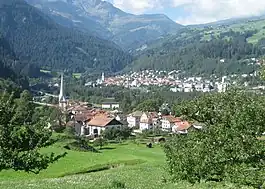 Sils im Domleschg (foreground) | |
 Coat of arms | |
Location of Sils im Domleschg | |
 Sils im Domleschg 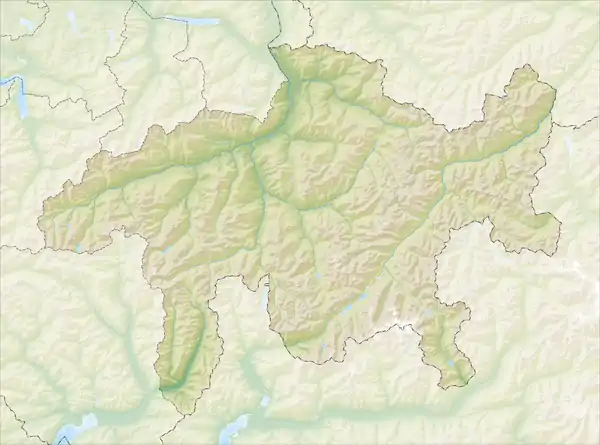 Sils im Domleschg | |
| Coordinates: 46°42′N 9°27′E | |
| Country | Switzerland |
| Canton | Graubünden |
| District | Viamala |
| Government | |
| • Mayor | Rudolf Hans Künzler |
| Area | |
| • Total | 9.28 km2 (3.58 sq mi) |
| Elevation | 633 m (2,077 ft) |
| Population (31 December 2018)[2] | |
| • Total | 943 |
| • Density | 100/km2 (260/sq mi) |
| Time zone | UTC+01:00 (Central European Time) |
| • Summer (DST) | UTC+02:00 (Central European Summer Time) |
| Postal code(s) | 7411 |
| SFOS number | 3640 |
| Surrounded by | Fürstenau, Mutten, Rongellen, Scharans, Thusis, Vaz/Obervaz, Zillis-Reischen |
| Website | www SFSO statistics |
History
Sils im Domleschg is first mentioned in 1149 as de Sillas.[3]
Geography
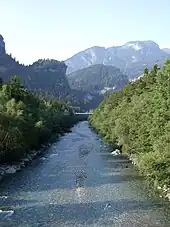
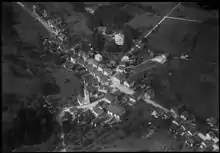
Sils im Domleschg has an area, (as of the 2004/09 survey) of 9.28 km2 (3.58 sq mi).[4] Of this area, about 14.6% is used for agricultural purposes, while 70.4% is forested. Of the rest of the land, 8.2% is settled (buildings or roads) and 6.9% is unproductive land.
In the 2004/09 survey a total of 35 ha (86 acres) or about 3.8% of the total area was covered with buildings, an increase of 4 ha (9.9 acres) over the 1984/85 amount. Of the agricultural land, 5 ha (12 acres) is used for orchards and vineyards, 78 ha (190 acres) is fields and grasslands and 64 ha (160 acres) consists of alpine grazing areas. Since 1984/85 the amount of agricultural land has decreased by 7 ha (17 acres). Over the same time period the amount of forested land has increased by 11 ha (27 acres). Rivers and lakes cover 11 ha (27 acres) in the municipality.[5][6]
Before 2017, the municipality was located in the Domleschg sub-district, of the Hinterrhein district, after 2017 it was part of the Viamala Region.[7] It is a linear village between the Albula and Hinterrhein rivers. It consists of the village of Sils im Domleschg and the hamlets of Freihof, Campi and Albula.
Demographics
Sils im Domleschg has a population (as of December 2020) of 971.[8] As of 2014, 16.3% of the population are resident foreign nationals. In 2015 a small minority (50 or 5.4% of the population) was born in Portugal.[9] Over the last 4 years (2010-2014) the population has changed at a rate of 5.60%. The birth rate in the municipality, in 2014, was 11.0, while the death rate was 5.5 per thousand residents.[6]
As of 2014, children and teenagers (0–19 years old) make up 21.5% of the population, while adults (20–64 years old) are 58.1% and seniors (over 64 years old) make up 20.3%.[6] In 2015 there were 365 single residents, 444 people who were married or in a civil partnership, 50 widows or widowers and 68 divorced residents.[10]
In 2014 there were 387 private households in Sils im Domleschg with an average household size of 2.36 persons. Of the 214 inhabited buildings in the municipality, in 2000, about 50.0% were single family homes and 32.7% were multiple family buildings. Additionally, about 28.0% of the buildings were built before 1919, while 15.9% were built between 1991 and 2000.[11] In 2013 the rate of construction of new housing units per 1000 residents was 7.82. The vacancy rate for the municipality, in 2015, was 2.37%.[6]
The historical population is given in the following table:[3][12]
| year | population |
|---|---|
| 1803 | 277 |
| 1850 | 295 |
| 1900 | 621 |
| 1910 | 541 |
| 1950 | 590 |
| 1960 | 737 |
| 1970 | 762 |
| 1980 | 826 |
| 1990 | 794 |
| 2000 | 880 |
Languages
Most of the population (as of 2000) speaks German (86.8%), with Serbo-Croatian being second most common (3.3%) and Italian being third (2.8%).[13]
| Languages in Sils im Domleschg | ||||||
| Languages | Census 1980 | Census 1990 | Census 2000 | |||
| Number | Percent | Number | Percent | Number | Percent | |
| German | 612 | 74.09% | 646 | 81.36% | 764 | 86.82% |
| Romansh | 56 | 6.78% | 34 | 4.28% | 14 | 1.59% |
| Italian | 104 | 12.59% | 60 | 7.56% | 25 | 2.84% |
| Population | 826 | 100% | 794 | 100% | 880 | 100% |
Heritage sites of national significance
Ehrenfels Castle, Carschenna (pre-historic petroglyphs), the ruins of Hohenrätien Castle and the ruins of Campell or Campi Castle are listed as Swiss heritage sites of national significance.[14]
 Carschenna petroglyphs
Carschenna petroglyphs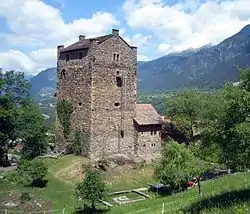 Burg Ehrenfels
Burg Ehrenfels Ruins of Hohenrätien
Ruins of Hohenrätien Ruine Campi (or Campell)
Ruine Campi (or Campell)
Politics
In the 2015 federal election the most popular party was the SVP with 35.8% of the vote. The next three most popular parties were the BDP (20.1%), the SP (15.1%) and the FDP (12.7%). In the federal election, a total of 287 votes were cast, and the voter turnout was 45.9%. The 2015 election saw a large change in the voting when compared to 2011. The percentage of the vote received by the SVP increased from 27.8% in 2011 to 35.8% in 2015, while the percentage that the BDP dropped from 31.1% to 20.1%.[15]
In the 2007 federal election the most popular party was the SVP which received 43.4% of the vote. The next three most popular parties were the SPS (27.4%), the FDP (19.7%) and the CVP (8.1%).[13]
Education
In Sils im Domleschg about 73.3% of the population (between age 25-64) have completed either non-mandatory upper secondary education or additional higher education (either university or a Fachhochschule).[13]
Economy
Sils im Domleschg is an industrial-tertiary municipality, a municipality where agriculture and manufacturing play a minor role in the economy.[16]
As of 2014, there were a total of 287 people employed in the municipality. Of these, a total of 14 people worked in 6 businesses in the primary economic sector. The secondary sector employed 160 workers in 21 separate businesses. A minority (25.6%) of the secondary sector employees worked in very small businesses. There were 5 small businesses with a total of 119 employees. Finally, the tertiary sector provided 113 jobs in 42 businesses.[17] In 2014 a total of 7.8% of the population received social assistance.[6]
Religion
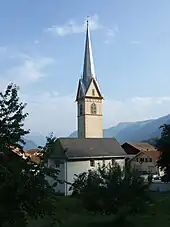
From the 2000 census, 700 or 33.0% are Roman Catholic, while 1,176 or 55.4% belonged to the Swiss Reformed Church. Of the rest of the population, there are 43 individuals (or about 2.03% of the population) who belong to the Orthodox Church, and there are 13 individuals (or about 0.61% of the population) who belong to another Christian church. There are 21 (or about 0.99% of the population) who are Muslim. There was 1 individual (or about 0.05% of the population) who belonged to another church (not listed on the census), 97 (or about 4.57% of the population) who belong to no church, are agnostic or atheist, and 71 individuals (or about 3.35% of the population) who did not answer the question.[18]
References
- "Arealstatistik Standard - Gemeinden nach 4 Hauptbereichen". Federal Statistical Office. Retrieved 13 January 2019.
- "Ständige Wohnbevölkerung nach Staatsangehörigkeitskategorie Geschlecht und Gemeinde; Provisorische Jahresergebnisse; 2018". Federal Statistical Office. 9 April 2019. Retrieved 11 April 2019.
- Sils im Domleschg in German, French and Italian in the online Historical Dictionary of Switzerland.
- Arealstatistik Standard - Gemeindedaten nach 4 Hauptbereichen
- "Arealstatistik Land Use - Gemeinden nach 10 Klassen". www.landuse-stat.admin.ch. Swiss Federal Statistical Office. 24 November 2016. Retrieved 27 December 2016.
- Swiss Federal Statistical Office - Regional portraits accessed 27 October 2016
- Swiss Federal Statistical Office - Amtliches Gemeindeverzeichnis der Schweiz - Mutationsmeldungen 2016 accessed 16 February 2017
- "Ständige und nichtständige Wohnbevölkerung nach institutionellen Gliederungen, Geburtsort und Staatsangehörigkeit". bfs.admin.ch (in German). Swiss Federal Statistical Office - STAT-TAB. 31 December 2020. Retrieved 21 September 2021.
- Federal Statistical Office - Ständige und nichtständige Wohnbevölkerung nach institutionellen Gliederungen, Geburtsort und Staatsangehörigkeit (Land) accessed 31 October 2016
- Swiss Federal Statistical Office - Ständige und nichtständige Wohnbevölkerung nach institutionellen Gliederungen, Geschlecht, Zivilstand und Geburtsort (in German) accessed 8 September 2016
- Swiss Federal Statistical Office STAT-TAB - Thema 09 - Bau- und Wohnungswesen (in German) accessed 5 May 2016
- Swiss Federal Statistical Office STAT-TAB Bevölkerungsentwicklung nach institutionellen Gliederungen, 1850-2000 (in German) accessed 27 April 2016
- Swiss Federal Statistical Office accessed 5 October 2009
- Swiss inventory of cultural property of national and regional significance Archived 2009-05-01 at the Wayback Machine 21.11.2008 version, (in German) accessed 05-Oct-2009
- Swiss Federal Statistical Office - Nationalratswahlen 2015: Stärke der Parteien und Wahlbeteiligung nach Gemeinden Archived 2016-08-02 at the Wayback Machine (in German) accessed 18 July 2016
- "Die Raumgliederungen der Schweiz 2016" (in German, French, Italian, and English). Neuchâtel, Switzerland: Swiss Federal Statistical Office. 17 February 2016. Retrieved 14 December 2016.
- Federal Statistical Office -Arbeitsstätten und Beschäftigte nach Gemeinde, Wirtschaftssektor und Grössenklasse accessed 31 October 2016
- Graubunden Population Statistics Archived 2009-08-27 at the Wayback Machine (in German) accessed 21 September 2009